Personalized videos are data-driven videos that are tailored to an individual’s interests, preferences, context or demographic background. They are used to engaging with them across the customer journey.
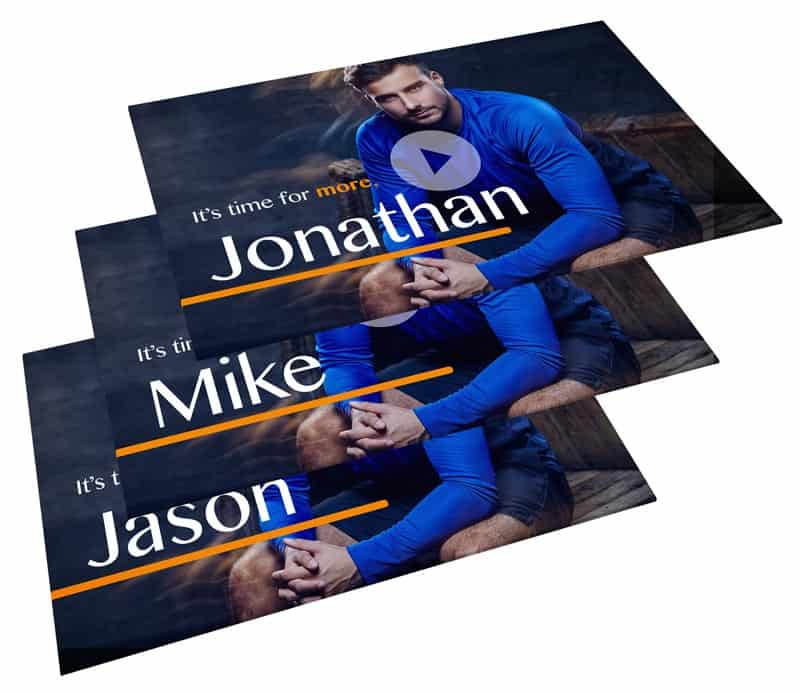
There is a clear reason why brands embrace video personalization.
In the age of information overload, customers are bombarded with a deluge of irrelevant interactions and messages from brands.
Perhaps, from yours too?
Amidst this noise, personalized videos stand out as a beacon of relevance.
These unique videos offer an exceptional opportunity to break through the clutter and connect with individual customers on a deeper level.
In this guide, you’ll learn how personalized videos can drive customer interaction, expand the customer base, increase loyalty, and boost revenue growth at every stage of the customer journey: awareness, consideration, decision, post-purchase, and advocacy.
Additionally, we will address seven common questions businesses have regarding personalized video marketing.
First, it is important to highlight why personalized content in marketing matters. And, particularly, why personalized video content.
Knowing this will help you understand what’s the best way to leverage personalized videos in your marketing.
Your Customers Are Distracted But Most Messages Are Irrelevant
Modern consumers are constantly surrounded by a vast amount of information, creating a phenomenon known as “information overload”.
As a result, they have developed the ability to quickly filter out irrelevant content and focus only on what they find meaningful.
This is what at Pirsonal we call “saturated audiences”.
This happens for two reasons:
- It is easier than ever to create and distribute commercial messages through digital channels. At the same time, most businesses have access to the same tools.
- Customers constantly receive and scan commercial messages all the time. Then, they are more educated and know what to ignore, which they proactively do.
“Normal” Marketing Is Becoming Less Effective
If customers are ignoring your messages even though you can easily reach them through various digital platforms, then the issue is not the quantity of messages you send.
Gone are those days. People expect a personal connection.
With this, over time, your marketing gradually loses its effectiveness. However, this has become the norm among marketers.
For example, to combat intrusive ads, numerous consumers now rely on ad-blockers, greatly diminishing the impact of conventional online advertising.
At the same time, advertising campaigns are becoming more expensive due to the increased number of brands and experienced marketers involved.
To make things worse, customers have even become immune to one-to-one marketing channels like email, SMS, and WhatsApp.
As a result, the adoption of an omnichannel approach has increased. Marketing and sales teams now (try to) work together to deliver a unified experience to their audience.
So, even if quantity does play an important role, it is not the main issue.
But, is it a channel issue or rather a strategy and content challenge?
Well, it’s mixed. Let’s see why.
Modern Marketing Is A Conversation
As I often say, marketing is a conversation.
And we can all agree on something: The best conversations are those full of context on both sides.
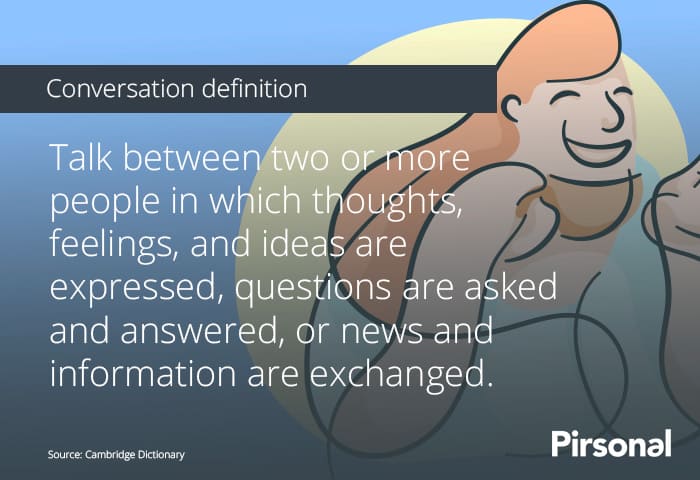
However, the majority of the marketing and sales messages we all get lack context, especially on the brand’s side.
The brand’s context is clear. But what about the target’s context?
The reality is that most marketing messages are too generic.
As a result, many marketing campaigns, no matter the channel, are irrelevant and fall short of effectiveness.
To add to this, the rise of mark tech in the last few years makes marketing tools available to every business.
This means that your competitors, no matter the industry, have access to the same software you use to engage with customers.
So, it’s not about quantity, budget, software or channel either.
It’s about the strategy and content to start, continue, and nurture conversations with customers.
Context is a key component for conversations to be both effective and engaging.
When you provide current and potential customers with this context, they add more to the conversation, and the relationship grows.
As a result, your marketing and customer engagement efforts become more effective.
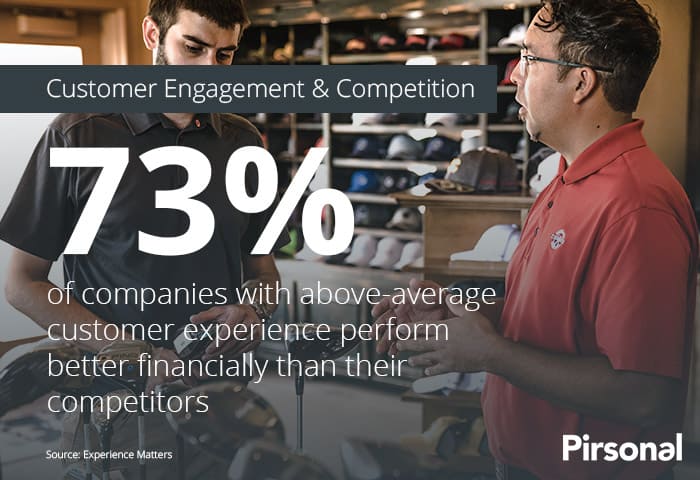
From a marketing standpoint, this context translates into personalized messages, interactions, and experiences.
But this is not what we regularly see in most marketing messages.
10 Reasons Why Businesses Need Personalization in Marketing
Consumers are inundated with generic advertisements, email marketing campaigns, and content daily.
As a result, this leads them to shorter attention spans and a diminishing impact of traditional one-size-fits-all marketing approaches.
Since context is key, marketers need to use their target audience’s context in their strategies and content to increase the effectiveness of their messages and interactions.
This is where personalization comes in as a powerful strategy to engage customers and build lasting relationships.
Let me share some key reasons for personalization in marketing.
1. Standing Out in a Crowded Market
To get people’s attention, brands must personalize their marketing messages and content based on what individuals prefer and need. This makes the audience feel valued.
When customers feel understood and catered to, they are more likely to choose a brand that resonates with their specific interests.
2. Enhancing Customer Experience
By leveraging data and insights, businesses can deliver relevant and timely content that addresses customers’ pain points and desires.
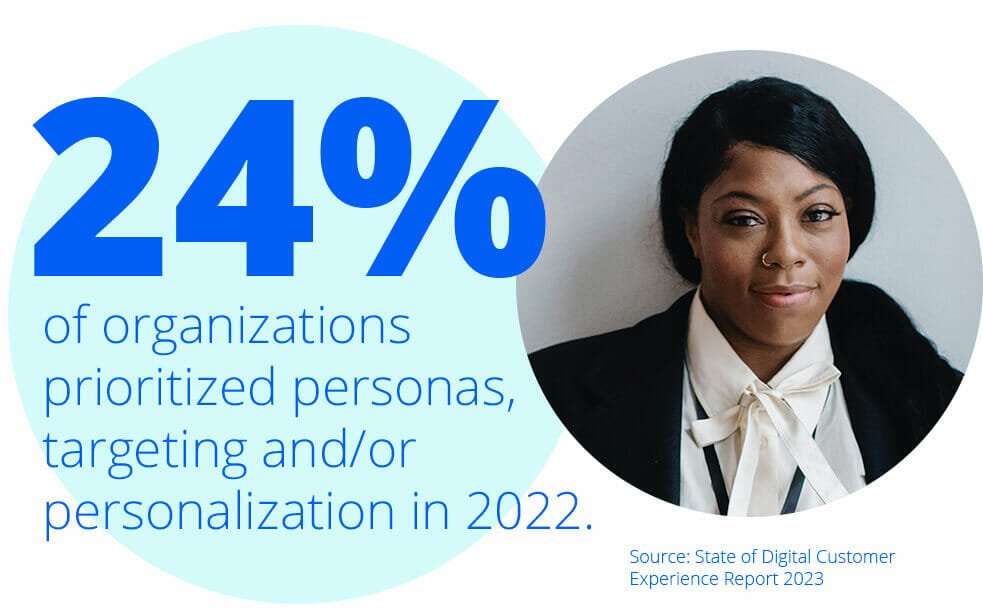
Whether it’s recommending products based on past purchases or sending personalized email campaigns, these efforts create a seamless and engaging experience throughout the journey.
3. Building Emotional Connections
Emotional connections play a vital role in any sales process. This lasting impact has a direct impact on brand loyalty and advocacy.
Personalization enables brands to connect with customers on a deeper level by aligning with their context, values, and aspirations.
Emotionally attached customers go beyond being buyers.
They become brand advocates who gladly promote and recommend your brand to others.
4. Increasing Customer Engagement
One-size-fits-all marketing often leads to disengagement, as customers feel bombarded with irrelevant content.
Personalization, on the other hand, encourages active engagement.
Interactive and personalized content, such as videos, quizzes, polls, and personalized product recommendations, entice customers to actively participate and interact with your brand.
5. Boosting Conversion Rates
Relevancy drives action. Personalized marketing messages that align with customers’ preferences and behaviors significantly improve conversion rates.
Whether it’s a tailored video email offer or a personalized product suggestion, customers are more likely to take the desired action when the content directly addresses their needs.
6. Leveraging Customer Data
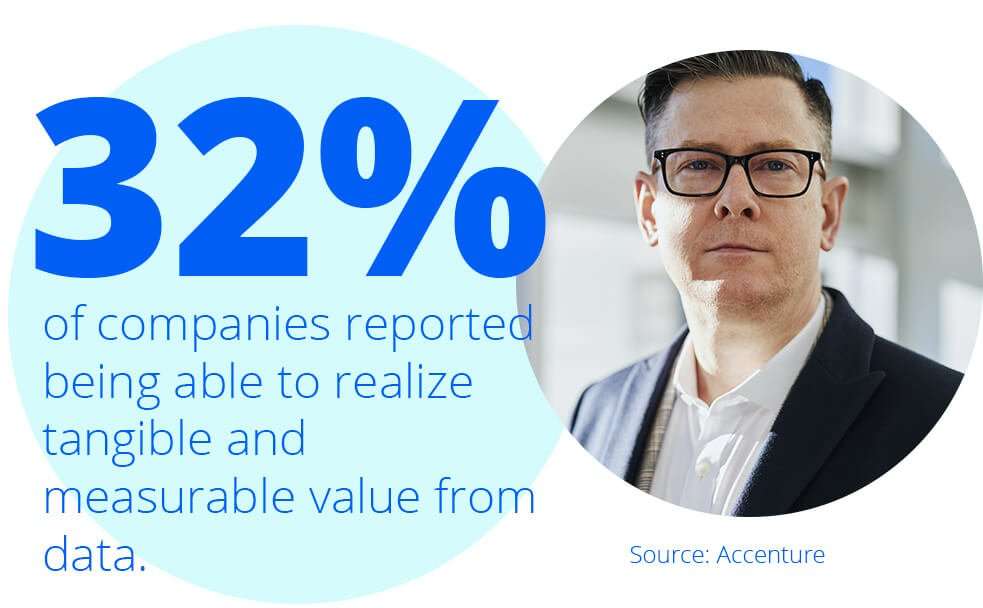
The abundance of customer data available today allows businesses to gain valuable insights into customer behavior and preferences.
Personalization leverages this data to create targeted marketing campaigns that resonate with specific segments of the audience.
Understanding customer CRM data, demographics, purchase history, and browsing behavior empowers your team to deliver personalized experiences.
7. Nurturing Customer Loyalty
In an age where customer retention is as crucial as customer acquisition, personalization plays a vital role in nurturing loyalty.
Loyal customers are more likely to make repeat purchases and spend more on products and services.
Personalized loyalty programs, exclusive offers, and personalized customer support foster loyalty and long-term relationships.
8. Adapting to Changing Consumer Expectations
Consumers have come to expect personalized experiences across all touchpoints.
Brands that fail to meet these expectations risk losing customers to competitors who offer more personalized interactions.
Embracing personalization is essential to adapt to changing consumer demands and preferences.
9. Gaining a Competitive Advantage
Incorporating personalization into marketing strategies provides a significant competitive advantage.
Brands that effectively personalize their offerings can outperform competitors that rely on generic marketing approaches.
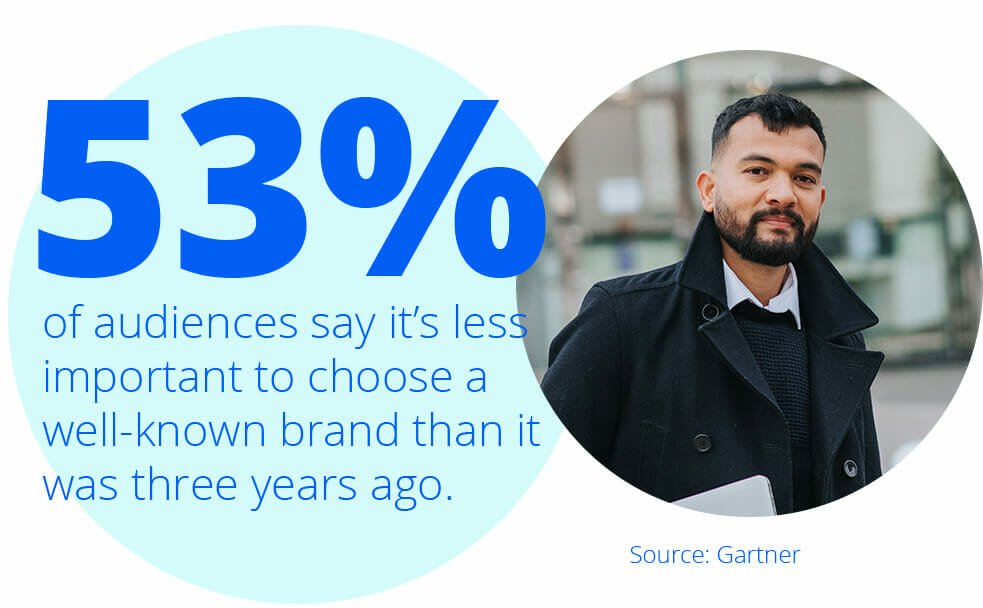
53% of audiences say it’s less important to choose a well-known brand than it was three years ago
Personalization becomes a key differentiator that sets a brand apart in the market.
10. Maximizing Marketing ROI
Personalization allows businesses to allocate resources more efficiently by targeting efforts on segments most likely to convert.
By focusing on high-value customers and tailoring marketing campaigns, businesses can maximize their return on investment (ROI) and improve marketing efficiency.
Now that you know why personalization in marketing matters, watch the following video to learn how to uplift your marketing with personalization:
Why Every Audience Type Loves Video
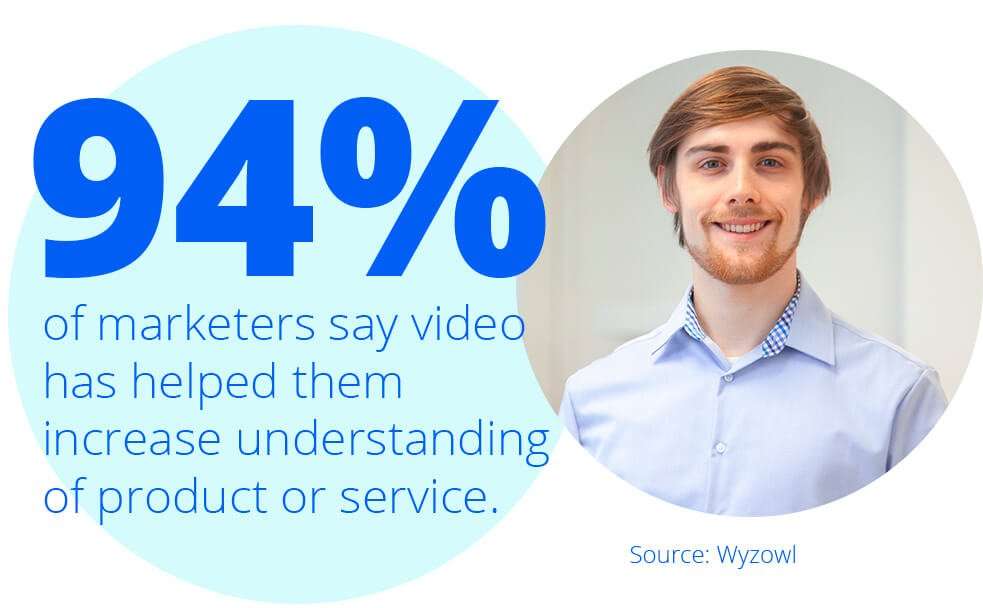
Video has become an incredibly popular and powerful medium for communication and entertainment.
From video emails, social media platforms to websites, video content is ubiquitous, and its popularity continues to grow rapidly.
It is the type of content brands use when they realize their marketing content is not sticky enough.
To add to this, video is the type of content we all consume the most.
This is why popular video platforms like YouTube, TikTok, and Twitch are so popular on both sides, creators and consumers.
But, is it always that effective?
Well, it is way more effective than other types of content such as text or images.
51% of people prefer sharing videos with friends over any other type of content, making it the most shareable form of online content.
However, as I mentioned earlier, today’s customers hate irrelevant interactions and video is not immune to this.
This alone sets the case for personalized videos.
Why Video Personalization Matters in the Modern Age
Video and personalization go hand in hand. This powerful combination anchors video, the most captivating content format, and the kind of information that truly matters to everyone: personalized.
Let’s see why businesses should make personalized videos:
- As I mentioned, in the age of information overload, consumers are increasingly drawn to content that resonates with their individual, context, interests, and needs. Not all customers are the same, and generic content often fails to engage.
- Personalization allows businesses to cut through the noise and deliver tailored experiences to each customer, enhancing brand loyalty and trust.
- Data-driven videos are becoming a dominant form of online 1:1 marketing. They offer a dynamic and immersive experience, capturing the audience’s attention like no other medium—at a personal level.
- From a digital customer experience perspective, video is the most impactful content since it focuses on two out of five senses (vision and hearing).
- Thanks to customer data, data-driven videos have the ability to evoke emotions, making customers feel understood.
- By tapping into their emotions with video, businesses can establish a stronger emotional bond with customers, fostering loyalty and advocacy.
- Individualized videos cater to each customer’s unique preferences, presenting content that aligns with their interests, context, and behavior.
As you can see, by combining the power of videos with personalization, businesses can create a potent tool for customer engagement.
But how can businesses leverage CRM data and individualized videos to support marketing and customer engagement strategies that help your business grow?
Let me share a few ideas with you taking into account every stage of the customer journey.
Using Personalized Videos Across the Customer Journey to Drive Engagement
Current and potential customer behavior, concerns, and needs change based on the buying stage.
The customer journey presents the following stages: awareness, consideration, decision, post-purchase, and advocacy.
To engage with your target audience based on their context, you can create individualized videos that cater to their different needs and preferences as you learn more about them over time.
Let’s explore this for every stage.
1. The Power of Personalized Videos in the Awareness Stage
At the awareness stage of the customer journey, the primary challenge for companies is capturing the attention of potential customers amidst fierce competition.
Traditional video marketing methods often fall short in this endeavor, as generic videos fail to resonate with individual interests and pain points.
Personalized videos provide the perfect antidote to this problem once you have captured the lead.
How Personalized Videos Overcome Challenges
Imagine receiving a personal video communication that speaks directly to your pain points, desires, and aspirations with an educational approach.
For example, the following video where Mitsubishi engages with leads as part of a direct mail campaign in the context of the brand’s anniversary.
As you can see, it’s an attention-grabbing approach that leaves a lasting impression.
For example, by crafting personalized explainer videos, companies can showcase their unique value proposition while addressing individual pain points.
These videos create a sense of one-on-one communication, fostering a stronger emotional connection with the viewer early in the buying process.
The result is a higher likelihood of potential customers progressing further along the customer journey.
This is how the car brand from the example above got a higher direct mail response rate when compared to other strategies.
Take into account, however, that individualized videos at this stage tend to show limited customer data.
In many cases, these videos only show the customer’s name.
To make these videos more relevant and attractive, focus on areas of interest to the market segment.
For instance, in the shared example, the brand focused on an influencer. This elevates the brand reputation and accelerates conversion rates.
Why is this Strategy Important?
Engaging potential customers at the awareness stage sets the foundation for the entire customer journey.
Personalized videos elevate the brand’s credibility, trustworthiness, and relevance, instilling a sense of confidence in the audience.
Metrics to Measure Success:
To gauge the effectiveness of personalized videos in the awareness stage, track video view rates, click-through rates (CTR), website traffic, and form submissions.
These marketing metrics will reveal how well the videos capture leads’ attention and drive them to explore further.
2. Personalized Videos in the Consideration Stage
As leads transition into the consideration stage, they are more inclined to explore different options and gather information about the company and its offerings.
However, the challenge lies in overcoming their skepticism and hesitation, especially when faced with perceived risks or uncertainty.
The Solution: Testimonials and Case Studies in a Personalized Format
Personalized testimonial videos featuring satisfied customers and case studies highlighting successful outcomes provide powerful social proof.
These videos demonstrate the real-world value of the service, inspiring confidence and trust in potential customers.
For example, in the following video, travel brand FlightCentre showcases the experience of other people when visiting Zanzibar.
As you can see from the video, at this stage brands usually know more about their potential customers.
In the data-driven video example, the brand shows the potential booking details for a couple interested in traveling to the destination.
They do this by increasing engagement with potential customers in a competitive market, creating excitement about their upcoming trips, and speeding up sales with an effective call-to-action.
To drive action right from the video, they use Pirsonal’s interactive video player.
This helps marketers add personalized call-to-action buttons (CTA) to the videos to increase video conversions.
Similarly, dynamic abandoned cart videos remind customers of their abandoned cart items to encourage them to complete their purchase right from the video.
Why is this Strategy Important?
Building trust and credibility at the consideration stage is vital to facilitate the decision-making process.
When leads witness others’ positive experiences, they are more likely to feel comfortable and confident about choosing your brand.
Metrics to Measure Success:
Measure lead conversions, how long it takes until the lead buys, form submissions, and the length of time spent on the website.
These metrics indicate how effectively personalized videos influence leads’ consideration and decision-making process.
3. Personalized Videos in the Decision Stage
The decision stage is a critical juncture where leads decide whether to become paying customers or not.
At this point, potential customers may require additional reassurance and incentives to take the final step.
The Solution: Personalized Offers and Incentives
Create personalized offer videos that provide exclusive deals or discounts based on the customer’s preferences and browsing history.
Tailoring these offers to individual interests makes customers feel valued and appreciated.
For example, in the following tailored video, a resort engages with a new guest to offer an upgrade.
At the same time, these videos are often distributed through branded, data-driven landing pages.
Thanks to these personalized landing pages, you keep the viewer’s attention intact as opposed to viewing the video on platforms like YouTube.
Another type of video that works really well at this stage is personalized follow-up videos. The most common scenario is account-based marketing and sales (ABM and ABS).
With Pirsonal, you automatically make interactive personalized videos and landing pages for every customer at scale all in one platform.
Take, for instance, the following infographic. It shows how real estate marketers can use personalized videos to engage with leads.
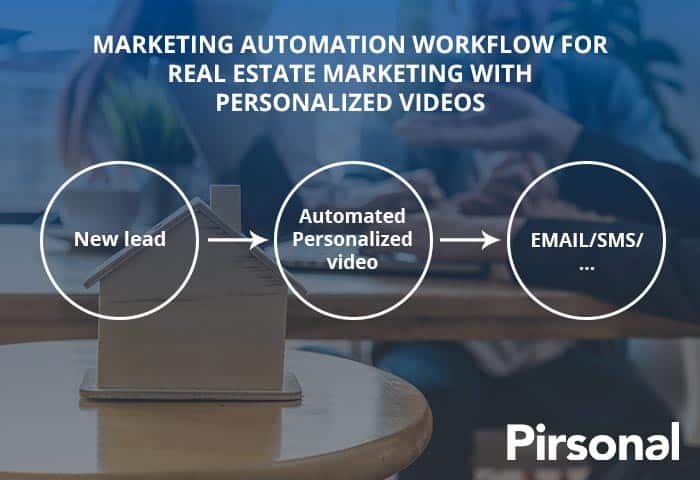
Use marketing automation and personalized videos to engage with real estate leads
This helps you save time and scale as you need.
Why is this Strategy Important?
Persuading customers to take action and make a purchase is the primary goal at the decision stage.
Personalized videos showcasing exclusive offers can be the final push that tips the scales in favor of your company.
Metrics to Measure Success
Track conversion rates, coupon redemptions, and the number of abandoned carts.
These metrics will indicate how effectively personalized videos drive customers to make a purchase.
4. Personalized Videos for Post-Purchase Engagement
The customer journey doesn’t end with a sale; it extends beyond, into the post-purchase stage.
Customers often need help understanding complex information and finding their way within a new service.
Marketers receive valuable information about new customers during the post-purchase stage because customers willingly provide zero and first-party data.
Then, providing a positive and engaging post-purchase experience is crucial for customer retention and fostering long-term loyalty.
However, many brands do not take advantage of this opportunity to impress and further assist customers in their growth with their products and services.
As a result, customers churn increases as expectations are not met and because of the lack of impact delivered by the brand’s product or service.
The Solution: Personalized Thank-You Videos and Onboarding Tutorials
There are many approaches businesses can follow depending on their goals and needs. For instance:
Sending personalized thank-you videos expressing gratitude and appreciation can leave a lasting impact on customers.
For example, in the following video, the brand sends a corporate Christmas video to its clients and leads.
Personalized onboarding video tutorials ensure customers understand how to use the product or service effectively.
In this video, a wealth management firm helps customers understand their financial goals:
Creating personalized videos to help customers understand their billing details and next steps.
These interactive how-to videos have a great impact.
Watch this customer onboarding case study to learn how a healthcare organization improved online payment speed after providing a service thanks to video personalization.
Increasing revenue with upselling and cross-selling through personalized videos.
In this example, Opodo, the online travel agency, improves customer experience by sending personalized videos via email before their flight.
Also, a personalized welcome video helps create a warm and friendly first impression, fostering a stronger emotional connection with new customers.
These videos not only provide valuable information but also present customers with various services they can buy to enhance their travel experience.
Why is this Strategy Important?
Fostering a strong post-purchase relationship is instrumental in driving customer retention and repeat business.
Personalized videos demonstrate that the company genuinely cares about each customer’s success and satisfaction.
As a result, customer churn and complaints decrease. Also, revenue, satisfaction, and word-of-mouth increase.
Metrics to Measure Success
Monitor customer retention rates, customer feedback, and product/service usage. These metrics will reveal how well-personalized videos contribute to customer satisfaction and increased loyalty that leads to advocacy.
5. Personalized Videos to Drive Advocacy
Turning satisfied customers into brand advocates is a powerful marketing strategy that leverages the power of word-of-mouth referrals.
Many brands miss this opportunity in different ways.
Large corporations put a lot of attention on getting new customers, but small and medium-sized companies try to keep customers by using traditional methods that often don’t connect with customers in a meaningful way.
The Solution: Personalized Referral and User-Generated Videos
Develop personalized referral videos that reward loyal customers for recommending the company to others.
Similarly, customized user-generated videos (UGT) videos are a great way for your audience to promote your brand on social media.
To protect your brand, use automatic video editing with Pirsonal so that every video always looks according to your brand’s standards.
In this video, pizza brand Papa John’s makes customized videos for their fans using the text provided by them. It is part of a brand and sponsorship campaign.
Another example is what fitness leader Zumba did with the following video campaign:
Their strategy was quite smart:
They made localized videos with personalization for their instructors worldwide, so they could easily share them via email, WhatsApp, and Twitter with their network or potential clients.
At the same time, the brand ran an ad campaign targeting the same audience.
These videos can include exclusive incentives for both the referrer and the new customer.
Why is this Strategy Important?
Advocacy generates organic growth, driving new customers and reinforcing brand trust.
Personalized referral videos incentivize customers to share their positive experiences, amplifying the company’s reach and impact.
Metrics to Measure Success
Track referral conversions, social media shares, and customer-generated content. These metrics will reveal how effectively personalized videos drive customer advocacy and organic growth.
A Powerful Combination: Using Generic and Data Videos in Marketing
Do personalized videos leave room for using non-personalized videos in marketing? Of course. Marketers should always focus on the type of content and strategy that better serves both their target audience and goals.
In the following video, I explain how to use generic and personalized videos strategically throughout the journey.
Overcoming Practical Challenges in Personalized Video Marketing
Starting with personalized video marketing can be challenging for most marketing teams. Many things could go wrong if you don’t know what to do.
One of the reasons behind this is that many don’t have experience with this type of marketing.
Pirsonal helps clients succeed in marketing with dynamic videos, regardless of their team’s experience or the number of videos they need.
In this video, I summarize some of the common mistakes you should avoid if you are considering personalizing videos for marketing and customer engagement:
Also, in this video you’ll learn how to work on the foundations of a personalized video project:
Now, let me cover some of the common challenges companies should take into account when considering video personalization in their marketing.
Data Privacy and Security
As personalized video messages rely heavily on customer data, ensuring data privacy and security is paramount.
Implementing robust data protection measures and being transparent with customers about data usage builds trust and credibility.
This is why it is important to work with an ISO 27001-certified personalized video vendor like Pirsonal.
Content Personalization at Scale
Personalizing videos for individual customers can be resource-intensive. However, leveraging automation and artificial intelligence can streamline the process, making content personalization scalable and efficient.
Allocating Time and resources
The average time to launch a campaign is 1 month. However, on many occasions, organizations make a decision late in the process and manage times that are not realistic with respect to their campaign objectives.
Lack of clear goals and strategy
The strategy is the most critical aspect of any successful personalized video program. Make sure you have clear goals, metrics, and a strategy in place.
Creating irrelevant messages
You can create personalized messages and still be totally irrelevant to your lead’s needs, context, and concerns of your target audience. Use augmented buyer personas.
This video will give you some ideas:
Wrong distribution channel
Most organizations use email to communicate with their leads and customers. Here is the bad news: If your opening rates are horrible, chances are that a campaign with personalized multimedia content won’t do that much.
First, optimize distribution and choose the right channel according to the audience.
Wrong customer data
We have “the power” to create hundreds of thousands of personalized videos automatically. But this power equals the power of making mistakes at scale.
Make sure your CRM data is accurate and up-to-date.
Lack of retargeting and remarketing
Simply make sure to create follow-up messages based on user behavior.
Conclusion
Personalized videos are revolutionary in customer engagement. They help companies stand out from generic marketing messages and create powerful one-on-one interactions using engaging and interactive video content.
Throughout the customer journey, from awareness to advocacy, personalized videos have the power to improve key metrics such as sales, upsells, cross-sells, lead engagement, time-to-value, decreased complaints, and overall customer engagement.
By embracing personalized video marketing, companies can forge stronger connections with leads and customers, fostering brand loyalty, and driving sustainable growth in today’s competitive market.
Common Questions about Personalized Video Marketing
1. How can we effectively gather customer data to personalize videos?
Utilize data from various sources such as customer surveys, website interactions, purchase history, and social media preferences. Implementing customer relationship management (CRM) tools can also streamline data collection and organization.
2. Isn’t creating personalized videos time-consuming and expensive?
While personalized videos may require initial effort and investment, flexible and scalable software to create personalized videos like Pirsonal make it efficient and cost-effective, especially because of the help our service team provides. Additionally, the returns on personalized video marketing efforts often outweigh the initial investment if the strategy is right.
3. How do we ensure that personalized videos are not intrusive or creepy to customers?
Transparency is key. Clearly communicate to customers the purpose and benefits of personalization. Obtain explicit consent for data usage and personalize videos based on relevant information that adds value to the customer’s experience.
4. How can we measure the success of personalized videos?
Align the metrics with the objectives of each stage in the customer journey. Key performance indicators (KPIs) could include video view rates, CTR, engagement rates, customer feedback, and customer retention rates.
5. What types of tools or platforms can we use to implement personalized video marketing?
Use specialized personalized video software that adapts to your team’s expertise, audience size, and workflow. Pirsonal is a flexible personalized video software that does just that. Various marketing automation tools integrate with Pirsonal, and it also provides an API for developers and easy ways to create videos from spreadsheets. Look for tools that provide customization options and analytics to optimize video performance.
6. What does the future hold for personalized video marketing?
The future of personalized video marketing is promising, with advancements in AI and machine learning leading to even more sophisticated personalization. Marketers can expect enhanced customer experiences and higher levels of engagement.
7. What data should I consider for personalized video marketing?
To make better personalized videos, use customer information like names, demographics, browsing behavior, past interactions with your brand, and purchase history. More importantly, interpret this data so that it is relevant to the customer’s eyes. This helps in crafting relevant and compelling video content.

